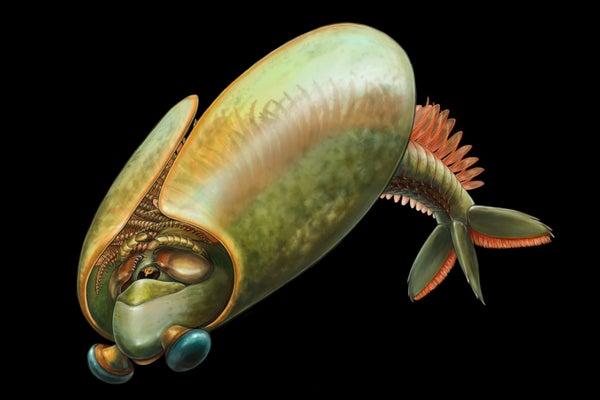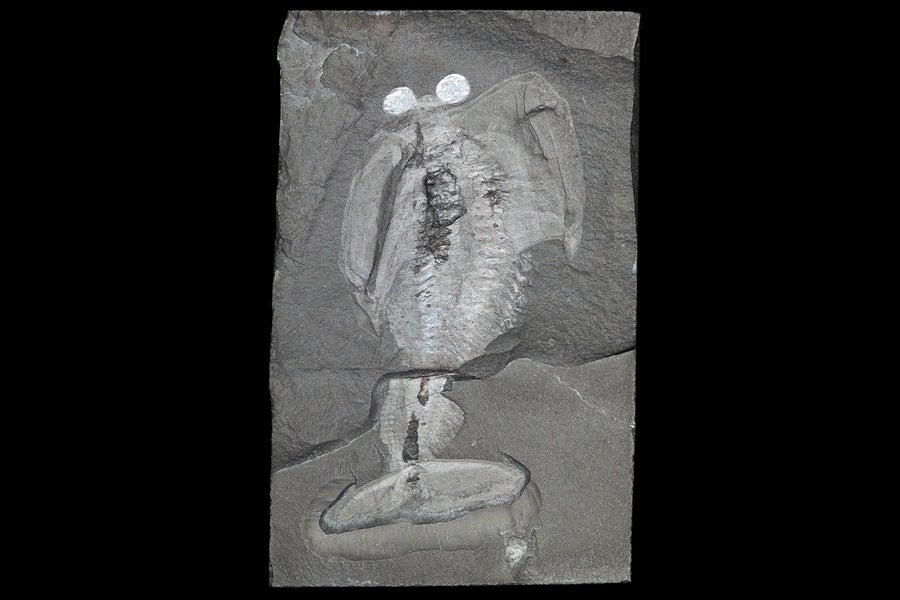500-Million-12 months-Outdated ‘Alien Fish Taco’ Was amongst First Creatures with Jaws
A weird fossil of a Cambrian creature that seemed like an “alien fish taco” reveals how a single group with jaws got here to account for round 90 % of all animal species on Earth

Odaraia (proven right here in a life reconstruction) might have used it is little spines to assist carry meals to its mouth. Researchers aren’t certain what the trident-shaped tooth in its mouth would have been used for.
Illustrated by Danielle Dufault. Courtesy Royal Ontario Museum
Round 500 million years in the past a wierd creature with bulging eyes, a rudderlike tail and 30 pairs of spiny limbs extending from its cigar-sized physique swam by means of Earth’s seas. Most of its legs couldn’t contact the ocean flooring as a result of they have been tucked inside a protecting shell that wrapped nearly fully round its midsection. And like a tiny King Neptune, it wielded a mysterious trident-shaped tooth between exterior jawlike buildings in entrance of its mouth.
Although it seemed extra like an alien fish taco, it was an arthropod referred to as Odaraia alata. The creature, spanning about 20 centimeters lengthy, doubtless met its finish very all of a sudden, buried beneath a thick layer of sediment. However the circumstances that spelled the animal’s doom additionally immortalized it within the fossil report.
Paleontologists discovered the fossilized stays of a number of of those creatures in 1912 within the now well-known Burgess Shale fossil web site within the Canadian Rocky Mountains. The very best-preserved Odaraia fossils have been examined once more within the Nineteen Seventies and Eighties, however for a number of a long time the specimens had remained in storage on the Royal Ontario Museum in Toronto.
On supporting science journalism
When you’re having fun with this text, think about supporting our award-winning journalism by subscribing. By buying a subscription you might be serving to to make sure the way forward for impactful tales concerning the discoveries and concepts shaping our world immediately.
Now scientists have taken a better take a look at one with exquisitely preserved jaws utilizing higher instruments and extra fashionable strategies. They have been notably fascinated about its mandible’s connection to the Cambrian explosion, when an unlimited array of extra superior organisms burst onto Earth’s stage round 540 million years in the past. Odaraia might have contributed to the modern-day dominance of creatures with mandibles, similar to bugs.

A fossil of an arthropod referred to as Odaraia was found in 1912 in what’s now referred to as the Burgess Shale fossil web site within the Canadian Rocky Mountains.
Jean-Bernard Caron, Royal Ontario Museum
“The evolution of the mandible ignited a feeding frenzy,” says Alejandro Izquierdo-López, an evolutionary biologist on the College of Toronto, who led the brand new research, revealed on July 23 within the Proceedings of the Royal Society B. “Animals with mandibles had a serious edge over competing organisms [because they] may break bigger buildings into items and achieve entry to new forms of meals.”
With this particular benefit, animals with mandibles rapidly took over the planet, changing into Earth’s most numerous animal group. Significantly due to this dramatic success, scientists have lengthy been fascinated about inserting the mandible’s emergence on an evolutionary timeline. The O. alata fossil helps them just do that.
“First, we needed to determine a Cambrian fossil that clearly confirmed the mandibles,” Izquierdo-López says. There had been some ambiguous identifications earlier than, however the workforce suspected the O. alata fossil could be a greater candidate. “These options are tiny, so we wished to take a look at a comparatively massive creature from a web site identified for wonderful preservation.” Discovering them on such an outdated specimen––courting again near the start of the arthropod fossil report, and which incorporates different very primitive options––confirms that these animals, a part of the evolutionary household referred to as odaraiids, have been among the many first to evolve mandibles. Animals with these mouthparts might have had a simple time shaping early meals webs as a result of ecosystems doubtless weren’t nicely developed.
Odaraia additionally had a second feeding benefit: its comparatively massive dimension. Most animals again then doubtless lived in small communities, seldom venturing far. Just a little creature could be restricted to such a group with a excessive sufficient focus of particles for it to feed on. However a comparatively massive creature may feed extra effectively, so it wouldn’t be confined to the ocean’s denser pockets of life and meals. Free of the shackles of the seafloor, Odaraia people may roam the open sea as they happy.
Till the current research, scientists didn’t totally perceive precisely how, or certainly whether or not, Odaraia may filter-feed. Derek Briggs, now a professor of earth and planetary sciences at Yale College, had initially inferred that odaraiidswere filter-feeders again within the early Eighties based mostly on their unusual kind.
“It has no greedy limbs and the (then restricted) proof of the trunk limbs point out that Odaraia may filter small animals by passing a circulate of water by means of the carapace,” or shell-like overlaying, Briggs stated in an e-mail to Scientific American. “The big eyes counsel that it may need sought out clouds of small animals (maybe larval types) within the water to feed on.”
The brand new research cracked the case of Odaraia’s filter-feeding mechanism by figuring out about 80 tiny spines on every of the creature’s legs, which collectively created a kind of mesh that would seize particles.
Being a big filter-feeder and evolving a mandible gave Odaraia a double benefit that contributed to an evolutionary arms race, because it pressed different animals to adapt sooner in response. Now scientists have set their sights on fixing a brand new thriller: O. alata’s sudden trident-shaped tooth. “It’s a construction that has not been seen in some other fossil from that point,” Izquierdo-López says. “We do not know how they advanced or why they aren’t present in some other animal.”



